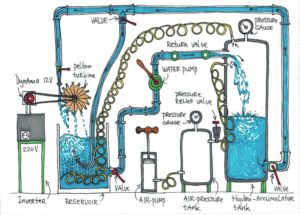Feeding the Human Power Plant: can calories be carbon-neutral?

We take a look at the food it may take to fuel the great Human Power Plant, an experiment in the making where students of Utrecht University in the Netherlands will power their very own carbon-neutral accommodation block.
We’ve been following the experiment led by Kris De Decker of Low Tech Magazine and artist Melle Smets here on the blog for some time now – find our first installment here and the second here – and it has raised some interesting questions along the way. One of the comments we received concerned the potential carbon footprint of the food which would be consumed by the residents in their quest to generate sufficient power to fuel their student lifestyles, mainly via a combination of manual gym machines and biogas from kitchen waste and their poo.
It seems this question of balancing calorie consumption with the holy grail of carbon neutrality is also of interest to the project’s partners and managers. They have attempted to shed some light on this in their most recent update How to Feed a Human Power Plant, a summary of which is provided below.
Back to basics
Whilst recognising the unique demands in place upon student participants in this experiment, let’s begin by considering what the typical calorie needs for a moderately active adult man and woman are. According to the UK’s National Health Service:
Within a healthy, balanced diet, a man needs around 10,500kJ (2,500kcal) a day to maintain his weight. For a woman, that figure is around 8,400kJ (2,000kcal) a day. These values can vary depending on age, metabolism and levels of physical activity, among other things.
According to Tamara Dean, author of The Human-Powered Home: Choosing Muscles over Motors, this total equates to 2.4 kilowatt-hours of energy or an average of 100 watts of power. The majority of this energy (70-90%) is used up in order to carry out basic bodily functions such as breathing, digestion, the pumping of blood around the body, cell regeneration and thought processes. Moderate daily activities typically raise the overall power usage by 30%, which meaning a rough total of between 90 and 120 watts.
In the case of the students living in the Human Power Plant block, levels of physical activity will of course be higher than the average, with each student typically expected to generate 100 watts of power via four hours of physical activity each day, a mix of individual and communal gym work, stair-climbing and water pumping. As a result, the humans in question will need to consume extra food, which in turn requires more energy to produce it.
Kris De Decker puts it like this:
The human body is not very efficient: the production of 100 watts of power requires 300 to 500 watts of energy in the form of food — similar to the conversion efficiency of a combustion engine. This comes down to roughly 300 to 500 calories per hour above the basal metabolism, or a total of 1,200 to 2,000 extra calories for 4 hours.

But what if these calories are coming from different types of diet? How do we account for balancing an omnivorous diet in contrast to a vegetarian or vegan diet? Citing two different studies in the UK and Greece, Kris goes on to assert that:
For a daily intake of 2,000 to 2,200 calories, the typical western diet (including more than 100g of meat per day) generates about 5 to 7 kg of CO2-equivalents per day. A vegetarian diet causes roughly 4 kg of CO2-equivalents, while a vegan diet produces the least greenhouse gas emissions, less than 3 kg of CO2-equivalents. Note that these are averages: the energy use and greenhouse gas emissions depend on the ingredients and the location.
If a meat eater produces 100 watt of power for four hours per day, he or she would generate 2.5 to 5 kg extra CO2-emissions. On the other hand, if 400 watt-hour of electricity would be taken from the Dutch electricity grid, the CO2-emissions would be only 0.148 kg. That’s 16 to 32 times less. A switch to a vegan diet can lower the carbon emissions of human power to 1.5 to 3 kg, but this is still much higher (10 to 20 times) than the CO2-emissions of grid electricity.
However, because students generate their own power, they have a strong incentive to use less power than students in other buildings. Energy use in the human powered building is at least 10 to 20 times lower than in a common student building. In combination with a vegan diet, the CO2-emissions of human powered electricity would thus be similar to those of grid electricity.
It seems there would be a strong incentive to switch to a vegan diet in this case but the students will have free rein to eat whatever they like, be it meat-based, vegetarian or vegan. I imagine that whatever’s cooking, however, will certainly include a whole lot of carbohydrates!
Cooking up a storm?
That said, there may not be as much cooking going on as you might expect, although that which will take place will follow the principles of retained heat or haybox cooking. Jokes about students’ cooking abilities aside, the reason for the lack of overall cooking is in fact because students have opted to eat raw food at least some of the time. Why? The answer comes in the form of a true Dutch dietary staple: cheese.
In order to enjoy their dairy fix in the least energy-intensive way possible, non-vegan students will make their very own cheese, using the by-product whey to in turn make protein shakes – who could resist? In order to enjoy the punishment, sorry, privilege of these purely nutritional protein shakes and, of course, their beloved cheese, the students will need to swap cooked food for raw food on the days during which these are produced. This should in theory balance out the thermal energy required in order to make the cheese in the first place.
Meanwhile, not forgetting the importance of a varied diet, the project proposes that:
To add surprises to the diet, students on cooking duty go dumpster diving in the city, mainly at the big supermarkets. This can bring food on the table that has a large CO2-footprint, however rescuing it from the garbage is obviously a good thing.
Down the hatch!
And speaking of garbage, let’s not forget that any food waste from the kitchen will in turn aid energy production thanks to the biogas plant in the basement.
The food waste from the kitchen and the excrements of 750 students are used to produce biogas that supplies the energy for cooking. On the other hand, energy use for cooking is reduced substantially by communal food preparation and the use of fireless cookers. After food is brought to a boil on a biogas fire, cooking pots are placed in a heavy insulated container, which keeps the cooking process going without the need for additional energy.

The use of excrements for biogas production requires the installation of vacuum toilets. These toilets separate the solid waste from the urine and transport it to the biogas installation in the basement with the use of very little water. Operating a biogas digester is labour-intensive: food waste needs to be collected, and all biodegradable material needs to be mixed with water, fed in the digester, and stirred.
So whether freegan, vegan or unashamedly cheese-chomping, it seems an interesting culinary future awaits the student residents of the Human Power Plant. With more than ample opportunity to burn off any additional calories, the benefits don’t end with digestion, thanks to the recycling of whatever happens to be left at the other end being handily converted to biogas.
Whether or not it will be possible to achieve the desired carbon-neutrality and exactly how this could be accurately measured across a diverse spectrum of potential eating and exercise habits remains to be seen. In the meantime, we’ll hear more soon on other aspects of the students’ anticipated daily routine, from washing to heating. Watch this space!
 About the author
About the author
Sophie Paterson works as part of the Lowimpact.org team with a focus on social media and book promotion. She spent the past year living and volunteering on a farm in Devon. In any spare time she undertakes natural building work and training and attempts to keep up her Arabic language skills.
The views expressed in our blog are those of the author and not necessarily lowimpact.org's
3 Comments
-
1Rosewood Farm's Robert Rose December 27th, 2017
This is an interesting theoretical experiment and I welcome the question of the food input but basing this upon bought-in food I think misses the fact you’d need to assess the whole cycle as a input of food also requires an output of money that itself will have a carbon footprint unless you are producing your own. Also, measuring the footprint based upon emissions alone, and not taking account of the source of that carbon does not tell you how sustainable it is. Fossil fuels may have a lower carbon footprint per unit of output but the timescale required to replace those inputs makes them unsustainable.
It was good to see that the dietary analysis paper (UK) took account of the limitations of using limited and theory based data but I found it odd that they tried to imply that beef consumption in the UK was actually increasing when the opposite is true. By choosing a reference period of 2000-2010 it is possible to give this impression but then they immediately mentioned the FAO stat data beginning in 1961. If you take beef consumption data from this point you get a very different and much more accurate picture of beef consumption dropping overall by 28% from 25kg/per capita/yr to 18kg/capita/yr.
-
2Sophie Paterson December 31st, 2017
Hi Rob, good to hear your thoughts on this. It’ll be curious to see on what basis they do decide to calculate and whether they will be taking into account the points you’ve raised here. Thanks for your insight on the beef consumption picture, too – very interesting to hear what a difference that change in time-frame makes.
-
3Rosewood Farm's Robert Rose January 17th, 2018
You’re welcome. It’s interesting how perceptions differ from the datasets, even within peer reviewed papers. On a worldwide scale per capita consumption has remained stable with only rising population accounting for an increase.




 Home-made biogas anaerobic digester
Home-made biogas anaerobic digester
 The great Human Power Plant experiment
The great Human Power Plant experiment
 The great Human Power Plant experiment: an update
The great Human Power Plant experiment: an update
 The Human Power Plant experiment: how many hours of power generation a day?
The Human Power Plant experiment: how many hours of power generation a day?
 Getting around the egg shortage – The Vegan Society’s top alternatives
Getting around the egg shortage – The Vegan Society’s top alternatives
 Do you know your carbon footprint? (And does it matter?)
Do you know your carbon footprint? (And does it matter?)
 Biogas
Biogas
 Cheesemaking
Cheesemaking
 Energy saving
Energy saving
 Low-impact cooking
Low-impact cooking
 Low-impact energy
Low-impact energy
 Low-impact food & drink
Low-impact food & drink
 Pedal-powered machines
Pedal-powered machines
 Raw / living food
Raw / living food
 Retained heat cooking
Retained heat cooking


